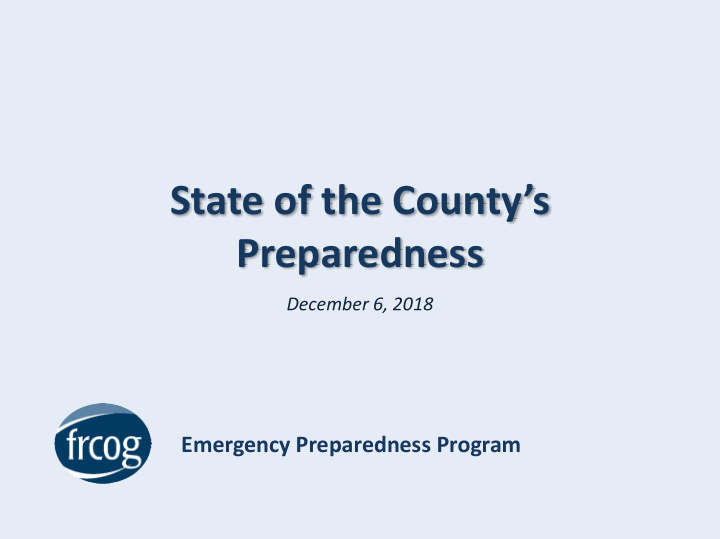



State of the County’s Preparedness December 6, 2018 Emergency Preparedness Program
Goals for the Evening • Enhance and improve emergency preparedness in Franklin County • Get a snapshot of: • Where we are • What we’ve done thus far • What we need to do in the future • Create written report to inform future work of FRCOG, local responders, local elected officials, and state/federal legislators
WHERE WE ARE
Demographic Context • Rapidly aging • Low income • High rates of substance use disorder • Drive far to get to work • Not reliable cell or broadband • Emergency responders are largely volunteers, working out of town
Geographic Context • Many rivers – And many dams – MANY Bridges • Many hills • Railroad lines • Long distances between neighbors • Private wells/septic systems
Climate Context • Increasing Near Term Hazards (2030s) – Hotter: 3.3°F – 4.5°F warmer average temps 9 – 13 more days above 90°F – Wetter: 2.5” – 3” more annual precipitation • Increasing Challenges – Exasperate (v): to increase the gravity or intensity of… – General threats require flexible plans
Our Strengths • Resilient Yankees • Reliance on wood heat • Most of us have our own cars • Culture of volunteerism • Long history of cross-town collaboration • Regional structures • Significant support for planning over the last decade
WHAT WE’VE ACCOMPLISHED
After Action Reviews Analyzed H1N1 Mass Vaccination -- 2009 • FC Regional Tropical Storm Irene – 2011 • Buckland Irene – 2011 • Colrain Irene -- 2011 • Greenfield Bioterror/Nuclear Tabletop -- 2011 • Elected Official Tabletop Exercise -- 2012 • Franklin/Hampshire REPC HazMat Full Scale Exercise -- 2016 • FC Mass Casualty Incident Exercise (MCI)Drill -- 2016 • Baystate Franklin Medical Center Surge Drill – 2016 • Conway Tornado – 2017 • Elected Official Tabletop Exercise: Twisted Sister -- 2017 • Winter Storms HMCC AAR – 2017 •
Progress Made on Areas of Improvement In The Last Decade Multi-Agency Coordination Center WRHSAC Resource Caches, Map, Guide DART Trailer, Pet Shelter Protocols Town Reverse 911 systems Real-Time Road Closure Mapping HMCC Duty Officer System
MORE Progress Made In The Last Decade Spontaneous Volunteer Management, JIT Trainings Public Info Officer Training Elected Officials E-Prep Series Debris Management Plan Community Organizations Active in Disasters (COAD) Shelter Plans and Drills
LOOKING TOWARD THE FUTURE
Challenges Remain 1. Technology 2. Awareness of, and access to, resources 3. Awareness and customization (operationalization) of plans 4. Awareness, expectations, and acceptance of emergency preparedness roles 5. Maintaining commitment to emergency preparedness
Challenge #1: Technology
Challenge #2: Resource Awareness & Access
Challenge #3: Awareness and customization (operationalization) of plans
Challenge #4: Role awareness, expectations, and acceptance
Challenge #5: Maintaining commitment to emergency preparedness
Challenge #6:
Small Group Work • Each table is for one of the challenges • Answer the following questions, realistically (i.e. something Franklin County could do or influence): 1. What trainings and exercises can address the problem? 2. Are there any plans that need to be written to address the problem? 3. What structural changes in emergency management or local government need to be made? 4. What policy changes at the local, state, or federal level are necessary? 5. What can the FRCOG do to assist?
Challenges 1. Technology 2. Awareness of, and access to, resources 3. Awareness and customization (operationalization) of plans 4. Awareness, expectations, and acceptance of emergency preparedness roles 5. Maintaining commitment to emergency preparedness 6. ?
Report Out
Next Steps Report • Presentation online • Survey monkey • Final report – Identify policy changes – Identify programming changes – Identify structural changes • Reconvene to discuss implementation
Thank You! Emergency Preparedness Program https://frcog.org/program-services/emergency-preparedness/ Tracy Rogers Program Manager emergencyprep@frcog.org 413-774-3167 x118
Recommend
More recommend